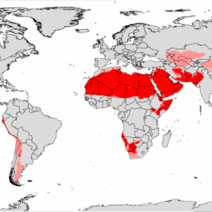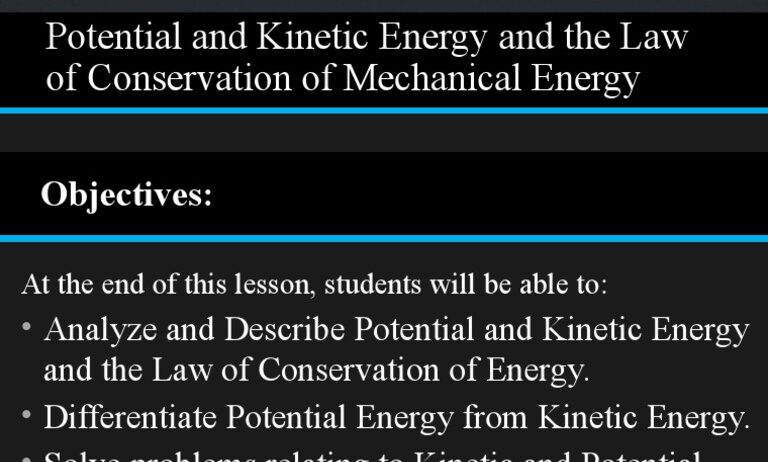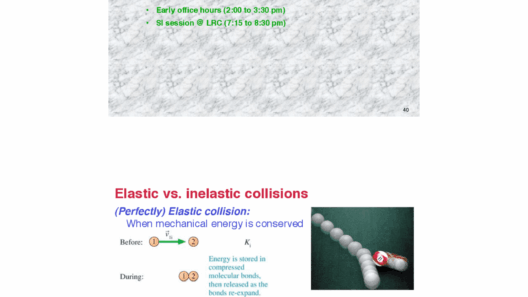In the intricate tapestry of physics, kinetic energy plays a pivotal role in understanding motion and the mechanics of conservation. Defined as the energy possessed by an object due to its motion, kinetic energy is not merely a scientific abstraction; it touches upon our everyday lives, offering insights into efficiency and sustainability. As we confront the pressing issues of climate change and energy conservation, it becomes imperative to delve into the physics behind kinetic energy and explore how we can master its conservation.
Kinetic energy is quantitatively expressed through the formula KE = 1/2 mv², where KE represents kinetic energy, m denotes mass, and v indicates velocity. This relationship illustrates that even small alterations in speed can result in substantial changes in energy. Consequently, the quest for conserving kinetic energy hinges upon effective strategies that optimize motion while minimizing waste. Understanding this foundational principle not only invites ecological mindfulness but also fosters innovative approaches that can significantly reduce energy consumption.
At its core, conserving kinetic energy involves recognizing the inherent potential of motion. When an object is in motion, it retains the ability to do work. The challenge lies in capturing and directing this energy efficiently. One of the most enlightened approaches relates to the design of transportation systems and vehicles. For instance, hybrid and electric vehicles capitalize on regenerative braking systems. These systems convert the kinetic energy generated during braking back into electrical energy, which can subsequently be used to power the vehicle or recharge its battery—a quintessential example of energy conservation married with kinetic energy principles.
Additionally, the integration of aerodynamics into vehicle design contributes to kinetic energy conservation. By streamlining shapes, automotive manufacturers can reduce drag forces that hinder motion. This enhancement not only amplifies the vehicle’s efficiency but also underscores the symbiotic relationship between physics and environmental stewardship. The less energy spent overcoming resistance, the more kinetic energy can be conserved for productive use.
Turning our attention to energy-efficient systems, the concept of momentum conservation also warrants exploration. In collisions, momentum—a vector quantity defined by the product of mass and velocity—is conserved in isolated systems. This principle serves as the backbone for various applications, from designing safer vehicles to more advanced athletic training methods. Athletes harness the principles of momentum and kinetic energy to optimize their performance, leveraging scientific knowledge to enhance efficiency and reduce energy expenditure. Understanding how our bodies move and interact with the environment offers a unique lens through which we can better conserve kinetic energy.
The energy dilemma extends beyond transportation; it beckons us to reconfigure our urban environments. Cities, teeming with motion and activity, can harness kinetic energy through innovative infrastructure such as piezoelectric materials. These materials convert mechanical strain—resulting from foot traffic, vehicles, or vibrations—into electrical energy. By embedding piezoelectric elements in pedestrian walkways or busy roads, urban planners can create self-sustaining energy sources that capitalize on the very motion that defines metropolitan life. Witnessing kinetic energy transform into usable power is not just a promise for sustainable cities; it is a tangible reality that beckons further exploration and implementation.
Yet, conserving kinetic energy also requires mindful consumption patterns. Across various facets of daily life, from household appliances to industrial processes, small adjustments can yield significant gains in efficiency. For example, home insulation enhances energy conservation by maintaining thermal equilibrium, reducing the kinetic energy expended on heating or cooling systems. Similarly, energy-efficient appliances that utilize less mechanical force to achieve the same task exemplify a thoughtful approach to conserving kinetic energy within our homes.
Looking toward the future, innovation holds immense potential for revolutionizing our relationship with kinetic energy. The advent of new technologies, particularly in the realm of renewable energy, encourages a paradigm shift. Solar panels, wind turbines, and hydroelectric systems derive kinetic energy from natural forces, reinforcing the idea that harnessing energy sustainably is both feasible and crucial. As we pivot toward a more resilient energy landscape, integrating kinetic energy conservation into these technologies becomes imperative for enhancing overall efficiency.
Moreover, as society steps into the age of the Internet of Things (IoT), the potential to monitor and analyze energy consumption in real-time provides unparalleled opportunities for optimizing kinetic energy use. Smart devices can be programmed to adjust energy usage based on kinetic activity, whether it be reducing power consumption when motion sensors detect inactivity in rooms or triggering energy-efficient modes in appliances at optimal times.
Ultimately, the exploration of kinetic energy conservation invites a profound shift in perspective. The interplay between energy, motion, and sustainability unveils a treasure trove of possibilities for reducing our ecological footprint. By adopting innovative technologies, rethinking urban designs, and embracing efficient consumption patterns, society stands poised to advance toward a more sustainable future—one where kinetic energy is conserved and celebrated as a powerful agent for change.
In conclusion, the significance of conserving kinetic energy permeates multiple layers of our lives. From the vehicles we drive to the cities we inhabit, the principles of motion and energy efficiency demand our attention. By fostering awareness and implementing practices grounded in the physics of kinetic energy, we hold the key to crafting a more sustainable and resourceful world. The questions we pose today about energy efficiency will surely shape the reality of tomorrow; thus, curiosity, innovation, and commitment to conservation will guide our journey toward lasting impact.








